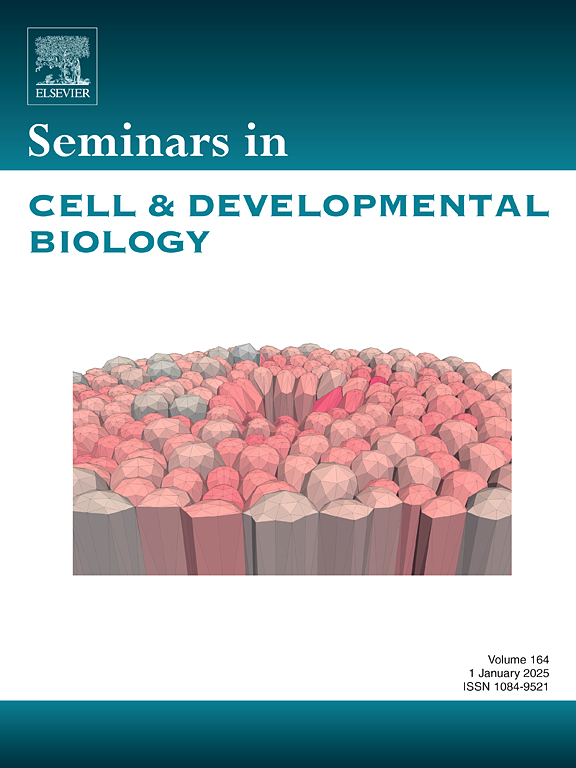Gossiping about death: Apoptosis-induced ERK waves as coordinators of multicellular fate decisions
IF 6
2区 生物学
Q1 CELL BIOLOGY
引用次数: 0
Abstract
Apoptosis is now recognized as a highly dynamic process that involves the release of a large set of signaling molecules that convey information to cells neighboring an apoptotic site. Recent studies in epithelial systems have discovered that apoptotic cells trigger waves of pulses of mitogen-activated protein kinase (MAPK) / extracellular signal-regulated kinase (ERK) pathway activity in their neighbors. At the single-cell level, the ERK pulses emerge from the MAPK pathway's excitable network properties, such as ultrasensitivity and adaptation. At the cell population level, apoptosis-induced ERK waves (AiEWs) emerge from propagation of ERK pulses across cells via a mechanism that involves mechanical inputs and paracrine signaling. AiEWs enable cell populations to dynamically coordinate fate decision signaling during tissue homeostasis and development. This spatio-temporal signaling mechanism can be hijacked by cancer cells to induce drug-tolerant persister states when apoptosis is triggered by cytotoxic or targeted therapies, undermining treatment efficacy. In this review, we summarize our current understanding of AiEWs, including their initiation, propagation, and coordination of fate decision signaling within a population. We discuss how the relatively simple properties of single cells, and their interactions within a collective coordinate these dynamic signaling patterns. We highlight their implication in resistance to cancer therapy and explore potential strategies to target these waves to re-sensitize cancer cells. Finally, we discuss emerging technologies and future directions to expand the study of this biological phenomenon.
关于死亡的八卦:凋亡诱导的ERK波作为多细胞命运决定的协调者
细胞凋亡现在被认为是一个高度动态的过程,涉及释放大量信号分子,将信息传递给凋亡位点附近的细胞。最近对上皮系统的研究发现,凋亡细胞在其邻近细胞中触发有丝分裂原激活蛋白激酶(MAPK) /细胞外信号调节激酶(ERK)通路活性的脉冲波。在单细胞水平上,ERK脉冲来自MAPK通路的可兴奋网络特性,如超灵敏度和适应性。在细胞群水平上,凋亡诱导的ERK波(AiEWs)是由ERK脉冲在细胞间传播产生的,其机制涉及机械输入和旁分泌信号。AiEWs使细胞群在组织稳态和发育过程中动态协调命运决定信号。当细胞毒性或靶向治疗引发细胞凋亡时,这种时空信号机制可被癌细胞劫持,诱导耐药持续状态,从而破坏治疗效果。在这篇综述中,我们总结了我们目前对AiEWs的理解,包括它们的起源、传播和种群内命运决定信号的协调。我们讨论了单个细胞的相对简单的特性,以及它们在一个集体中的相互作用如何协调这些动态信号模式。我们强调了它们在癌症治疗耐药中的意义,并探索了靶向这些波使癌细胞重新敏感的潜在策略。最后,我们讨论了新兴技术和未来的发展方向,以扩大这一生物现象的研究。
本文章由计算机程序翻译,如有差异,请以英文原文为准。
求助全文
约1分钟内获得全文
求助全文
来源期刊
CiteScore
15.10
自引率
1.40%
发文量
310
审稿时长
9.1 weeks
期刊介绍:
Seminars in Cell and Developmental Biology is a review journal dedicated to keeping scientists informed of developments in the field of molecular cell and developmental biology, on a topic by topic basis. Each issue is thematic in approach, devoted to an important topic of interest to cell and developmental biologists, focusing on the latest advances and their specific implications.
The aim of each issue is to provide a coordinated, readable, and lively review of a selected area, published rapidly to ensure currency.

 求助内容:
求助内容: 应助结果提醒方式:
应助结果提醒方式:


